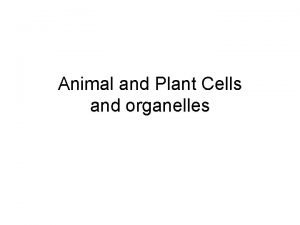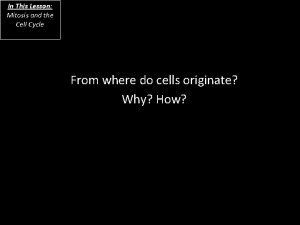Chapter 5 Cell Activities 5 1 The Concept





















































































- Slides: 85

Chapter 5 Cell Activities 5. 1 The Concept of Metabolism 5. 2 The Roles of Enzymes in Metabolism 5. 3 Factors Affecting Enzyme Activities 5. 4 Transporting Materials in and out of Cells

What is metabolism? • All chemical activities taking place inside the body cells of an organism are collectively called metabolism Examples: • Bone and wood: contain living cells carry out metabolism • Finger nails and shells: truly dead materials no metabolism

Catabolism complex molecules simpler molecules Examples: • Digestion complex food molecules simpler molecules enhance absorption • Respiration glucose carbon dioxide & water release energy

Anabolism simpler molecules complex molecules Examples: • Photosynthesis - combination of simple inorganic molecules (carbon dioxide & water) complex organic molecules (glucose)

Metabolic rate = the overall speed of the chemical reactions in the organisms Low metabolic rate at rest High metabolic rate when active

Why are enzymes so important? • Catalysts: substances that speed up chemical reactions • Enzymes: catalysts which speed up chemical reactions inside the cells Enzymes = biological catalysts • Enzymes – maintain metabolic rate – may work inside or outside of the cells (e. g. digestive enzymes in the gut)

What are the properties of enzymes? • • • Made up of proteins Speed up the rates of chemical reactions Are regenerated / reused after reaction Effective in very small quantities Easily affected by changes in temperature and p. H Very specific in the reactions they catalyse

How do enzymes work? Based on experimental evidence, scientists have proposed a hypothesis to explain how enzymes work and why enzymes are so specific in their actions: Lock-and-key hypothesis Substrate : the reacting molecule in an enzymecatalyzed reaction Active site : the particular site of the enzyme for reaction to occur; specific for each type of enzyme Enzyme-substrate complex : an unstable structure formed by the enzyme and substrate molecules during reaction

Lock (substrate) Key (enzyme) Enzymesubstrate complex Opened lock (product) Key (enzyme, remain unaffected) The lock-and-key hypothesis of enzyme action

Enzyme action in a catabolic reaction

Enzyme action in an anabolic reaction

Practical 5. 1 Investigating the presence of catalase in various plant and animal tissues Introduction Catalase is an enzyme that speeds up the breakdown of hydrogen peroxide into water and oxygen. It is an example of catabolic reaction. Procedure 1. Prepare six boiling tubes in a holder. 2. Add 5 cm 3 hydrogen peroxide solution into each tube. 3. Add a small piece of potato, apple, meat, liver and boiled liver of similar sizes into five of the tubes respectively. Do not add any tissues into the last tube.

4. Note whether any gas is evolved in each tube. Test the gas with a glowing splint. 5. Measure the highest point reached by the bubbles in each tube.

Analysis 1. What is the purpose of testing boiled liver? Ans: To show the effect of boiling on the activity of the enzyme catalyse in liver 2. What is the purpose of doing the test in a test tube without any tissue? Ans: It acts as a control set-up 3. Compare the results obtained. Give a conclusion for this experiment. Ans: Different tissues may contain different amounts of catalase so that they have different rates for the same reaction ~ End of Practical 5. 1 ~

Factors Affecting Enzyme Property of Enzyme: • Protein has an active site with a particular threedimensional shape maintained by weak bondings Under certain conditions: Breaking of weak bondings Change in shape of the active site Affect enzyme activity

How does temperature affect enzyme activity? Enzyme activity = the rate of substrate utilization or product formation

From 0 – 40/50 C • Rise in temperature increase the rate of an enzyme-catalyzed reaction Effect of temperature on enzyme activity

Reasons at higher temperature, the substrate molecules move faster higher chance for collision with the active sites higher chance to form enzyme-substrate complexes greater amount of product molecules

Above 50 C • Reaction rate drops rapidly stops completely at 70 - 80 C Effect of temperature on enzyme activity

Reasons at high temperature breaking of weak bondings change in shape of the enzymes and their active sites lose the catalytic activity enzyme is denatured

Around 0 C • Very low reaction rate Reasons movement of the substrate molecules slow down at low temperature there is less chance for the substrate molecules to collide with enzyme molecules enzyme is inactivated

Optimum temperature • The temperature at which an enzyme-catalyzed reaction occurs most rapidly • Specific to different enzymes • Lies around 45 C for most enzymes Effect of temperature on enzyme activity

How does p. H affect enzyme activity? • p. H the degree of acidity or alkalinity of the reaction medium • Small changes in p. H greatly affect the enzyme activities • Each enzyme has its optimum p. H • Most enzymes work best at p. H 5 to 9, but some work best at an extreme p. H

When p. H optimum p. H change in enzyme structure decrease in activity Effect of p. H on enzyme activity

When there is drastic changes in p. H denaturation of enzyme a great decrease in catalyzing ability Effect of p. H on enzyme activity

Critical Thinking 5. 1 The optimum p. Hs of some enzymes The graph below shows the effect of p. H on the activities of three different enzymes.

Questions 1. Which enzyme works best in alkaline conditions? Ans: Trypsin 2. Which enzyme works best in acidic conditions? Ans: Pepsin 3. Which enzyme works best in neutral conditions? Ans: Salivary amylase 4. What is the range of p. H at which each enzyme is active? Ans: Pepsin: p. H 1 -3; salivary amylase: p. H 5. 5 -8. 5; trypsin: p. H 7. 5 -10. 5

Practical 5. 3 Investigating the effect of temperature on the activity of amylase Introduction Amylase is a type of digestive enzyme found in saliva and the gut. It speeds up the breakdown of starch. In this experiment, we are going to test the effect of temperature on the activity of amylase.

Procedure 1. Prepare six water baths with the following temperatures: - 0 C - room temperature - 40 C - 60 C - 80 C - 100 C 2. Put 1 cm 3 of amylase solution into each of six test tubes, and place them into the suitable water baths. 3. Put 4 cm 3 of starch solution into each of six other test tubes, and place them into the suitable water baths.

4. After 5 minutes, pour the amylase solution from a test tube into the starch solution in the test tube in the same water bath. 5. After 10 minutes, pour 5 cm 2 of Benedict’s solution to each tube and shake gently. Boil for 5 minutes. 6. Shake the tubes at 1 -minutes intervals. Note the colour changes of the mixtures. Compare the amount of brick-red precipitate formed in the six tubes.


Analysis 1. What is the purpose to keep the test tubes containing the starch solution and amylase solution in each water baths for about five minutes before mixing? Ans: To ensure that both starch and amylase solutions have reached the desired temperatures before mixing 2. What is the optimum temperature for the action of amylase? Ans: At 60 C 4. Explain the effect of temperature on the activity of amylase. Ans: Amylase is inactive at 0 C. The rate of reaction increases steadily with temperature, and reaches the maximum at the optimum temperature of 60 C. Beyond the optimum temperature, the reaction rate drops rapidly and finally stops completely due to denaturation of enzyme

Practical 5. 4 Investigating the effect of p. H on the activity of amylase Introduction In this experiment, we are going to test the effect of p. H on enzyme activity. Amylase is extracted from mung beans for the test.

Procedure 1. Soak 10 mung beans in water for two days. 2. Remove the seed coat. Grind them with 2 cm 3 of distilled water.

3. Filter the mixture and collect the filtrate in a test tube.

4. Prepare and label six cavities of a spot tile as follows: 5. A: Amylase extract + 1 drop of distilled water 6. B: Dilute hydrochloric acid (HCl) 7. C: Amylase extract + 1 drop of dilute HCl 8. D: Dilute sodium bicarbonate solution (Na. HCO 3) 9. E: Amylase extract + 1 drop. Aof dilute Na. HCO 3 B 10. F: Distilled water C D E F

5. Prepare six small filter paper discs. 6. Put one filter paper disc into each of cavities A to F. A B C D E F

7. Drain away excess liquid from the paper discs, and put them onto a starch-agar plate. 8. Incubate the starchagar plate at 40 C for half an hour.

9. Remove the paper discs from the plate. Flood it with iodine solution for 1 minute and then flush gently with tap water. 10. Observe the colour changes.

Analysis 1. Why do we carry out the tests for the liquids in the cavities A, C and E in the spot tile? Ans: To investigate the amylase activity at neutral, acidic and alkaline conditions respectively 2. Why do we carry out the tests for the liquids in cavities B, D and F in the spot tile? Ans: They act as control set-ups 3. Why do we incubate the agar plate at 40 C instead of room temperature? Ans: It provides an optimum temperature for most enzyme-catalyzed reactions 4. In which medium does amylase work best? Ans: In an alkaline medium 5. From the results, give a conclusion for this experiment. Ans: Amylase works best in an alkaline medium ~ End of Practical 5. 4 ~

Practical 5. 5 Comparing the protease activities in different fruit juices Introduction In some fruit juices, there are enzymes that can break down proteins. We will use a milk-agar plate to compare the protease activities of different types of fruits.

Procedure 1. Prepare a milk-agar plate. 2. Prepare a small amount of juice from each of several types of fruits (e. g. pineapple, kiwi fruit, papaya, guava and mango) by using a mortar and a pestle. 3. Collect the filtrate and dilute with distilled water (2 cm 3 of filtrate with 8 cm 3 distilled water).

4. Remove 6 circular discs of agar from the agar plate. 5. Fill a well in the milk-agar with two drops of a fruit juice. 6. Incubate the plate at 40 C for 1 to 2 hours. 7. Note and measure the diameter of the clear zone around each well.

Analysis 1. Suggest a sample for the control experiment. Ans: Distilled water 2. How are the clear zones formed in the milk agar? Ans: In some fruits, there are enzymes (proteases) that can break down proteins. If the milk protein in the milk-agar plate is digested, a clear zone will appear in the agar plate 3. What is the relationship between the diameter of the clear zone and protease activity? Ans: The higher the protease activities, the larger the diameter of the clear zone

Further Investigation You may do a similar experiment to compare or study the protease activities of the following solutions: 1. biological washing powder, 2. meat tenderizer, 3. protein-removal tablets for contact lenses. ~ End of Practical 5. 5 ~

Making use of enzymes in everyday life Questions for Discussion 1. Why are commercial enzymes mainly obtained from microorganisms? Ans: It is because the reproductive rate of microorganisms is fast and the yield of commercial enzymes is high 2. Why is it possible to obtain maltose from Ans: Starch is converted to maltose by amylase starch?

3. Why can proteases be used to make meat more tender? Ans: Proteases partially break down proteins in the meat tissues that are originally responsible for its tough nature 4. Why can proteases be used to remove egg stains and blood stains from clothes? Ans: Proteases can break down the proteins present in egg stains and blood stains ~ End of Enrichment Reading 5. 1 ~

Activities of the cell Various supplied to substances Cells removed from Waste product Carry out various life processes, such as - releasing energy - building up cellular structures

Cell membrane • Has many tiny pores • Selectively permeable • Allows some particles to pass through but not others Processes involved in transport of materials • Diffusion • Osmosis • Active transport

What is diffusion? • The net movement of the particles of a substance from a region of higher concentration to a region of lower concentration • The net movement continues until the concentration of the substance in the two regions are the same • It is a passive process

Concentration gradient • The difference in concentration between two regions where diffusion occurs • Determines the rate and the direction of diffusion

Critical Thinking 5. 2 The diffusion of ink in water A small amount of blue ink was put in a beaker containing water. The photographs below show the colour change of the water immediately, 10 minutes later and 20 minutes later.

Questions 1. How does the colour of the water change within 20 minutes? Ans: The blue colour spreads out gradually in water 2. Explain the colour change. Ans: Ink particles spread from a region of high concentration to a region of low concentration by diffusion

Questions 3. What do you expect to see if the solution is allowed to stand for a long time? Are the ink particles still moving at this state? Ans: The water will become blue evenly; ink particles are still moving randomly 4. Will the result be different if the demonstration is carried out at a higher temperature? Why? Ans: The blue colour will spread out much faster, because the ink particles possess more kinetic energy

What factors affect the rate of diffusion? 1. Molecular size – Small particles diffuse faster than larger particles 2. Concentration gradient / difference – Diffusion occurs more rapidly if there is a larger difference in concentration between two regions 3. Distance of diffusion – Diffusion occurs more slowly if the distance betweem the two regions is longer

4. Surface area – For substances diffusing through a membrane, a larger surface area promotes a faster rate of diffusion 5. Temperature – Diffusion occurs more rapidly with a rise in temperature (because the kinetic energy of particles increases)

Why is diffusion important to organisms? It is important in the exchange of useful and wasteful substances between: • cells and body fluids • the organism and its surroundings Examples: • Gas exchange in the breathing organs of animals • Gas exchange on the leaf and stem surfaces of plants • Absorption of digested food in the small intestine

What is osmosis? Osmosis refers to the diffusion of water from the dilute solution to the concentrated solution across a selectively permeable membrane

Why does osmosis occur? What will happen when a concentrated sucrose solution is separated from a dilute sucrose solution by a selectively permeable membrane? Note: The membrane has numerous tiny pores that allow small particles (e. g. water molecules) to pass through, but not larger particles (e. g. sucrose molecules)

• Region B contains a higher proportion of sucrose molecules and a lower proportion of freely moving water molecules • In a sucrose solution, the sucrose molecules and water molecules are in continuous, random motion

• Only water molecules can pass through the membrane in both directions and more pass from region A to region B • There is a net movement of water molecules from dilute to concentrated solution across the membrane

• Osmosis is a special type of diffusion • Takes place only when a selectively permeable membrane is present • Definition: the diffusion of water molecules from a dilute solution to a more concentrated solution across a selectively permeable membrane

What is water potential? • Water potential is the total energy for the water molecules in a solution to move about • Net movement of water molecules: from a region of higher water potential to a region of lower water potential • Pure water has the highest water potential, its water potential is defined as zero • When substances are dissolved in water, water potential become less than zero • Concentrated sucrose solution has a lower water potential than dilute sucrose solution

How does osmosis affect organisms? Water molecules may move into or out of the cell by osmosis depending on the concentration of substances dissolved in the fluid around a cell 3 terms to describe the relative concentration of solutions: • Hypertonic • Hypotonic • Isotonic

Hypertonic solution • A solution with a water potential lower than that of another solution, e. g. the water potential of the solution in the cell • When animal cells are placed in a hypertonic solution: water leaves the cell by osmosis shrinking • When plant cells are placed in hypertonic solution: water leaves the cell by osmosis shrinking of cytoplasm becomes separated from cell wall (i. e. cell is plasmolysed) plant tissue becomes flaccid

Red blood cells shrink ( 4 000) Plant cells become plasmolysed

Hypotonic solution • A solution with a water potential higher than that of another solution, e. g. the water potential of the solution in the cell • When animal cells are placed in hypotonic solution: water enters the cell by osmosis expand or even burst • When plant cells are placed in hypotonic solution: water enters the cell by osmosis expand, but swelling is limited by the cell wall become turgid

Red blood cells swell ( 4 000) Plant cells become turgid

Isotonic solution • A solution with the same water potential as that of another solutions, e. g. the water potential of the solution in the cell • Important to maintain a suitable water potential of body fluids (e. g. the blood)

No net movement of water into or out of the cell Water leaves the cell Immersed in isotonic solution Immersed in hypertonic solution The cell shrinks and becomes plamolysed Water enters the cell Immersed in hypotonic solution A plant cell The cell swells and becomes turgid

The cell shrinks An animal cell Immersed in hypertonic solution Water leaves the cell Immersed in isotonic solution The cell swells and eventually burst Immersed in hypotonic solution Water enters the cell No net movement of water into or out of the cell

Importance of osmosis to plants • For water absorption - water potential of the root epidermal cells is lower than that of soil water - water moves from the soil (higher water potential) into the root epidermal cells (lower water potential) • For support - young, non-woody plants depend entirely on turgidity for support - if water loss is significant, plant tissue will become flaccid and the plant will wilt

Practical 5. 6 Studying osmosis by using a dialysis tubing Introduction The phenomenon of osmosis can be demonstrated by: • using a selectively permeable membrane • using two solutions of different concentrations

Procedure 1. Soak a dialysis tubing in water. 2. Open up and tie a knot close to one end of the dialysis tubing. 3. Fill the dialysis tubing with 20% sucrose solution. 4. Tie the other end of the dialysis tubing to a 1 cm 3 pipette. 5. Wash the dialysis tubing with distilled water. 6. Place the dialysis tubing into a beaker of distilled water. 7. Measure & record the change in liquid level. 8. Set up a control.

Analysis 1. Why do we rinse the outer surface of the dialysis tubing? Ans: To avoid introducing sucrose solution to the surrounding medium 2. How does the volume of sucrose solution in the dialysis tubing change with time? Ans: It rises with time, indicating that the volume of sucrose solution in the dialysis tubing increases 3. Explain the result of this demonstration. Ans: There is a net movement of water molecules into the sucrose solution from surrounding through the selectively permeable membrane by osmosis ~ End of Practical 5. 6 ~

Practical 5. 7 Studying osmosis in a living plant tissue Introduction Instead of using a dialysis tubing, a living tissue (potatoes) can be used to demonstrate osmosis.

Procedure 1. Peel off the skins of potatoes and make 3 potato cups.

2. Place the potato cups into three petri dishes containing distilled water, and label as: - A (unboiled, cavity filled with distilled water) - B (unboiled, cavity filled with sucrose solution) - C (boiled, cavity filled with sucrose solution) 3. Observe the change in the level of the solution in each potato cup 24 hours later.

Analysis 1. Describe your observation. Ans: There is an increase in the liquid level in B. The liquid level remains more or less unchanged in A. The level of the sucrose solution in C drops until it is equal to the level of distilled water outside.

2. Explain the changes in liquid level in A, B and C. Ans: A: no osmosis occurs, because there is no concentration difference between distilled water in the cavity and that in the petri dish; B: osmosis occurs, because distilled water has a higher water potential than that of the sucrose solution. Water molecules diffuse across potato cells into the cavity; C: no osmosis occurs, because strong heat kills the potato cells and destroys their cell membrane which become freely permeable. The sucrose solution moves out of the cavity until its level is equal to the level of water outside

3. At the end of the experiment, in which set-up, B or C, may we find sucrose in the water outside the potato cup? Explain briefly. Ans: We may find sucrose in the water outside the potato cup in set-up C because the cell membrane of potato cells in C become freely permeable after strong heating. Thus, the sucrose molecules move out of the cell into the distilled water outside. ~ End of Practical 5. 7 ~

What is active transport? Active transport • It is need, for instance, to transport substances against a concentration gradient • It is a process of transporting substances across the cell membrane with the use of energy • It can only take place in living cells • It involves carriers (special protein molecules) located on the cell membrane

Movement of substances against the concentration gradient Low concentration outside the cell Substance to be transported Carrier molecule Cell membrane High concentration inside the cell 1. The substance enters the carrier molecule The action of the carrier protein in active transport 2. The carrier molecule combines with the substance and changes its shape. The energy needed for this comes from respiration 3. The change of shape of the carrier molecule releases the substance into the cell

Why is active transport important to organisms? • Enables a cell to take in useful substances / remove waste substances against the concentration gradient • Allows the transport of substances across the membrane when: - diffusion is too slow - there is no concentration gradient

Examples: In the human body: • Absorption of glucose by the cells lining the small intestine • Absorption of minerals by the cells lining the kidney tubules In plants: • Absorption of minerals from the soil
 Biology.arizona.edu/cell bio/activities/cell cycle/01.html
Biology.arizona.edu/cell bio/activities/cell cycle/01.html Chapter 4 cell theory and cell study
Chapter 4 cell theory and cell study The statement of cash flows helps users
The statement of cash flows helps users Outdoor and indoor sports
Outdoor and indoor sports Primary and support activities
Primary and support activities Primary activities and secondary activities
Primary activities and secondary activities Biosphere concept map
Biosphere concept map Directs all the activities of the cell
Directs all the activities of the cell Corn plant
Corn plant Hát kết hợp bộ gõ cơ thể
Hát kết hợp bộ gõ cơ thể Frameset trong html5
Frameset trong html5 Bổ thể
Bổ thể Tỉ lệ cơ thể trẻ em
Tỉ lệ cơ thể trẻ em Gấu đi như thế nào
Gấu đi như thế nào Chụp phim tư thế worms-breton
Chụp phim tư thế worms-breton Chúa yêu trần thế alleluia
Chúa yêu trần thế alleluia Môn thể thao bắt đầu bằng chữ đua
Môn thể thao bắt đầu bằng chữ đua Thế nào là hệ số cao nhất
Thế nào là hệ số cao nhất Các châu lục và đại dương trên thế giới
Các châu lục và đại dương trên thế giới Cong thức tính động năng
Cong thức tính động năng Trời xanh đây là của chúng ta thể thơ
Trời xanh đây là của chúng ta thể thơ Cách giải mật thư tọa độ
Cách giải mật thư tọa độ Làm thế nào để 102-1=99
Làm thế nào để 102-1=99 Phản ứng thế ankan
Phản ứng thế ankan Các châu lục và đại dương trên thế giới
Các châu lục và đại dương trên thế giới Thể thơ truyền thống
Thể thơ truyền thống Quá trình desamine hóa có thể tạo ra
Quá trình desamine hóa có thể tạo ra Một số thể thơ truyền thống
Một số thể thơ truyền thống Cái miệng bé xinh thế chỉ nói điều hay thôi
Cái miệng bé xinh thế chỉ nói điều hay thôi Vẽ hình chiếu vuông góc của vật thể sau
Vẽ hình chiếu vuông góc của vật thể sau Thế nào là sự mỏi cơ
Thế nào là sự mỏi cơ đặc điểm cơ thể của người tối cổ
đặc điểm cơ thể của người tối cổ Ví dụ giọng cùng tên
Ví dụ giọng cùng tên Vẽ hình chiếu đứng bằng cạnh của vật thể
Vẽ hình chiếu đứng bằng cạnh của vật thể Fecboak
Fecboak Thẻ vin
Thẻ vin đại từ thay thế
đại từ thay thế điện thế nghỉ
điện thế nghỉ Tư thế ngồi viết
Tư thế ngồi viết Diễn thế sinh thái là
Diễn thế sinh thái là Các loại đột biến cấu trúc nhiễm sắc thể
Các loại đột biến cấu trúc nhiễm sắc thể Các số nguyên tố là gì
Các số nguyên tố là gì Tư thế ngồi viết
Tư thế ngồi viết Lời thề hippocrates
Lời thề hippocrates Thiếu nhi thế giới liên hoan
Thiếu nhi thế giới liên hoan ưu thế lai là gì
ưu thế lai là gì Khi nào hổ con có thể sống độc lập
Khi nào hổ con có thể sống độc lập Khi nào hổ mẹ dạy hổ con săn mồi
Khi nào hổ mẹ dạy hổ con săn mồi Sơ đồ cơ thể người
Sơ đồ cơ thể người Từ ngữ thể hiện lòng nhân hậu
Từ ngữ thể hiện lòng nhân hậu Thế nào là mạng điện lắp đặt kiểu nổi
Thế nào là mạng điện lắp đặt kiểu nổi Real self vs ideal self venn diagram
Real self vs ideal self venn diagram Perbedaan pemasaran dan penjualan
Perbedaan pemasaran dan penjualan Concept map of cell cycle mitosis and meiosis
Concept map of cell cycle mitosis and meiosis Transport in plants
Transport in plants Cell transport concept map
Cell transport concept map Concept map cell cycle
Concept map cell cycle Mitosis fun facts
Mitosis fun facts Cell city analogy
Cell city analogy Difference between mercury cell and diaphragm cell
Difference between mercury cell and diaphragm cell Site:slidetodoc.com
Site:slidetodoc.com Prokaryotic
Prokaryotic Animal cell and plant cell venn diagram
Animal cell and plant cell venn diagram The cell reaction for the zn-h2 cell is
The cell reaction for the zn-h2 cell is Dry cell vs wet cell
Dry cell vs wet cell Plant cell vs animal cell venn diagram
Plant cell vs animal cell venn diagram What is the function of cell wall in plant cell
What is the function of cell wall in plant cell Plant cell structure
Plant cell structure Structure of plant and animal cell
Structure of plant and animal cell Cell wall cell membrane
Cell wall cell membrane 10 cm dish surface area
10 cm dish surface area Cell line vs cell strain
Cell line vs cell strain Cell city project animal cell
Cell city project animal cell Primary and secondary cells
Primary and secondary cells Differences between plant animal and bacterial cells
Differences between plant animal and bacterial cells Cell-cell junction
Cell-cell junction Cell-cell junction
Cell-cell junction Which organelle prepares proteins for specific jobs
Which organelle prepares proteins for specific jobs Cell cycle and cell division
Cell cycle and cell division Life
Life Eukaryotic cell animal cell
Eukaryotic cell animal cell Cell organelle graphic organizer
Cell organelle graphic organizer Idealized plant cell
Idealized plant cell Walker cell and hadley cell
Walker cell and hadley cell Prokaryotic vs eukaryotic cells
Prokaryotic vs eukaryotic cells Cell cycle and cell division
Cell cycle and cell division











































































































